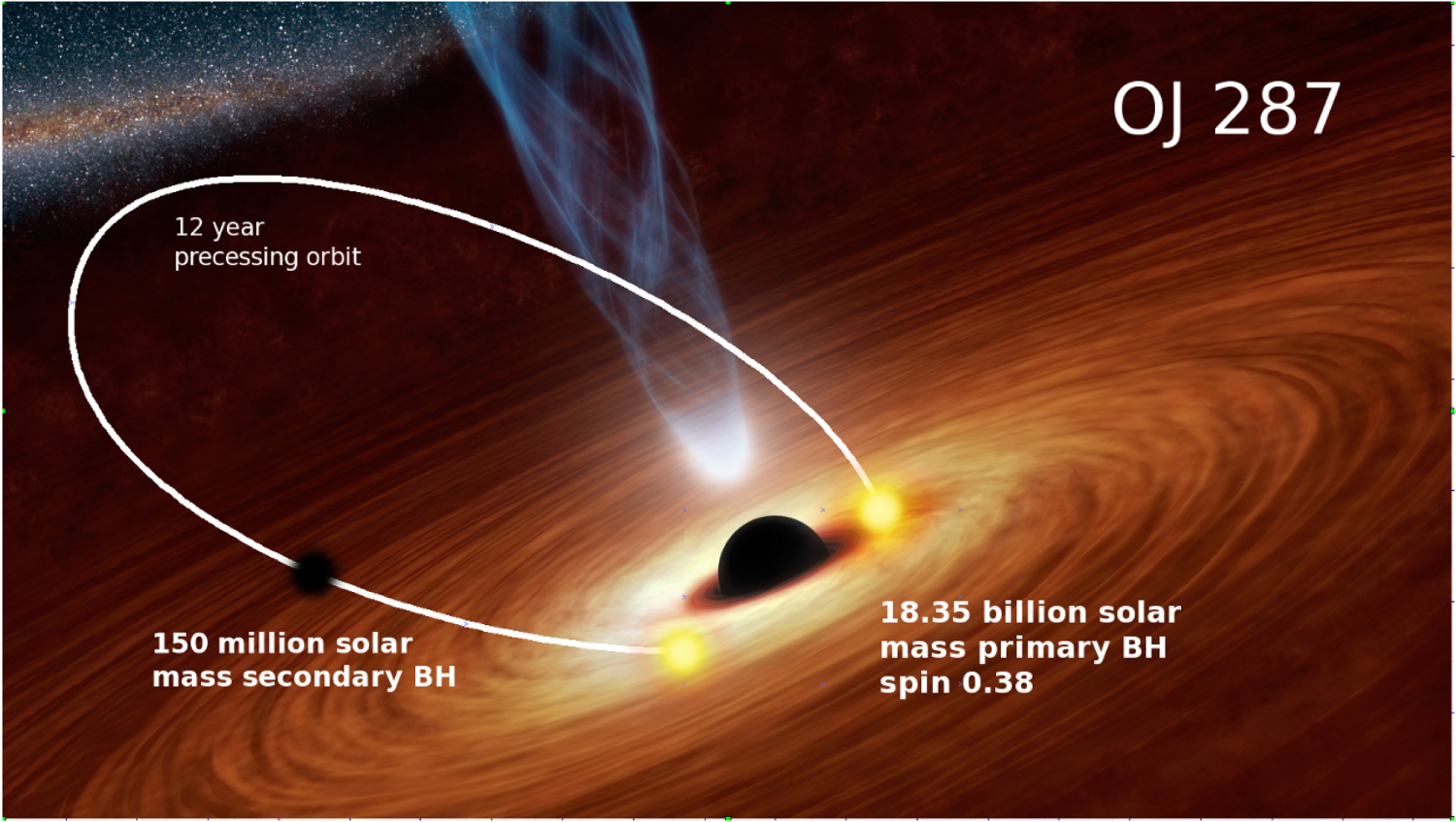At the heart of the galaxy OJ 287 is a supermassive black hole, like almost every other galaxy, but this one is unusual. Around it orbits a smaller black hole, but one still far bigger than the one in our own galaxy. Astronomers have suspected for decades the flares from this galaxy were a product of these two enormous objects’ interactions. Only now, with the help of two space telescopes, have they made a direct observation of the smaller black hole.
The supermassive black holes (SMBHs) at the center of galaxies are surrounded by accretion disks made of material that is slowly spiraling down to them to be swallowed. Depending on the amount of material in the disk at any time, these can be exceptionally brilliant, and may flare up when the disk is disturbed.
Usually, however, we don’t know when to expect such an outburst, but astronomers at the University of Turku have been studying OJ 287 for 40 years, and anticipated one in late 2021. Other astronomers had enough confidence in the prediction, that they diverted the Transiting Exoplanet Survey Satellite (TESS) from its primary role of finding planets around nearby stars and had it check up on OJ 287 frequently for 80 days.
That decision was vindicated when TESS, along with the Swift X-ray telescope, observed the flare right on time. Along with observations made the following year, but published more quickly, these confirm the Turku model, revealing two enormous black holes in an epic dance.
The previous flare occurred when the smaller SMBH passed through the larger one’s accretion disk, disrupting it in ways that produced a surge in brightness. However, in this case, the extra light came from the area around the smaller SMBH itself.
OJ 287 lies 4 billion light years away, so it is astonishing how bright it is, visible in large amateur telescopes. It also has a history of odd behavior, attracting the attention of astronomers since the 19th Century, who at the time had no idea what they were looking at. Now, we know OJ 287 is a blazar, a type of quasar where the jets point straight at Earth, but there is more to it than that.
OJ 287 has flared many times. For his PhD 40 years ago, Aimo Sillanpää constructed the theory that we were seeing two SMBHs, one much larger than the other. Naturally, the smaller one orbits its bigger neighbor, and the 12-year cycle of this orbit creates one of the periods Sillanpää tracked between flares. The smaller SMBH orbits at an angle to the plane of the accretion disk, so it passes through twice each orbit, the disruption leading to an outpouring of extra light.
This would be a fascinating thing to see under any circumstances, but the scale of this system is staggering. The smaller black hole has a mass 150 million times that of the Sun, making it 40 times as massive as Sagittarius A*, the SMBH at the heart of our own galaxy. The bigger object is about 18 billion solar masses.

Another representation of OJ 287, showing how the smaller SMBH’s orbit is angled to the accretion disk, only passing through twice in 12 years.
Image Credit: AAAS 2018
Despite the size of the smaller black hole, there are usually obstacles to its direct detection. “The two black holes are so close to each other in the sky that one cannot see them separately, they merge to a single point in our telescopes,” said Professor Mauri Valtonen in a statement. “Only if we see clearly separate signals from each black hole can we say that we have actually ‘seen’ them both.”
In addition to the flares Sillanpää tracked, there are other events triggered by the two SMBH’s interactions. While working on his own PhD in 2014, Dr Pauli Pihajoki developed the model further to predict the smaller SMBH would capture a richer pocket of gas in late 2021 and flare up, inspiring the observations by TESS and Swift.
On November 12 at 2 am GMT, TESS observed OJ 287 brightening and tracked it for 12 hours before it faded again. Swift and ground-based instruments were also on the case, and those experiencing clear nights got to watch the flare as well.
Professor Mauri Valtonen has led a project to analyze the data from all these instruments and compare it with Sillanpää and Pihajoki’s predictions.
They found that for that 12-hour period the smaller SMBH outshone its bigger sibling, giving the system a yellow color rather than the usual red.
“Therefore, we can now say that we have ‘seen’ an orbiting black hole for the first time, in the same way that we can say that TESS has seen planets orbiting other stars,” Valtonen said in a different statement. “Just as with planets, it is extremely difficult to get a direct image of the smaller black hole. In fact, because of OJ 287’s great distance … it will probably take a very long time before our observation methods have developed enough to catch a picture even of the larger black hole.”
The team looked back on the dates when such an event should have occurred previously, and found that telescopes powerful enough to detect the change had never been watching at the right time.
Besides studying OJ 287 at all points on the electromagnetic spectrum, the University of Turku team think that two such enormous objects orbiting so close to each other should be producing gravitational waves in the nano-Hertz range. Those waves should be causing pulsars across the universe to alter their timing fractionally, and the team hope we will soon be able to measure some precisely enough to pick this up.
The findings are open access in The Astrophysical Journal Letters.
Source Link: Secondary Supermassive Black Hole In Exceptional Pair Observed Directly For First Time